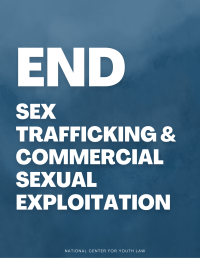New Report Shows Positive Results From Collaborative, Trauma-Informed, Youth-Centered Responses to CSEC
The National Center for Youth’s Law’s ongoing collaboration with Los Angeles County to combat the commercial sexual exploitation of children and youth and serve those who are exploited is having a meaningful impact. Since the launch of the Law Enforcement First Responder Protocol in 2014, 361 young people have been identified and provided services under the Protocol. Kate Walker Brown, Director of NCYL’s Collaborative Responses to Commercial Sexual Exploitation Initiative, along with partners from the Probation Department and the Department of Children and Family Services, presented the results of a four-year review of the Protocol to the Board of Supervisors on November 13.
This groundbreaking Protocol has become a national model for collaborative, trauma-informed, youth-centered responses to commercial sexual exploitation of children and youth (CSEC). When first implemented, the Protocol represented a sea change in the way children who were commercially sexually exploited were identified, treated, and ultimately served by law enforcement and their partners. Even though children could still be arrested under prostitution laws in California prior to 2017, Los Angeles County demanded better. In lieu of arrest, the Protocol defines key steps for law enforcement, public agencies and community-based partners to take within the first 72 hours after they come into contact with a child or youth suspected of being commercially sexually exploited. These critical steps include connecting the young person to a specialized social worker or probation officer and a community-based advocate, and obtaining an expedited medical exam and urgent medical care if needed.
The report presents insights into the profile of young people vulnerable to sexual exploitation and the impact of the services provided through the Protocol. Highlights of the findings include:
- The average age of first recovery by law enforcement was just under 16 years old, and the youngest child was eleven years old.
- The youth identified through the Protocol were disproportionately African American (71%) and 85% had a prior referrals to the child welfare agency.
- 5% of youth received a medical evaluation in the first 72 hours after being recovered.
Youth were more stable after receiving services through the Protocol - Fewer than 25% of the identified youth had left home or care (AWOL) after the first 72 hours. And continued support and engagement resulted in more stabilization—fewer than 12% of all youth recovered were AWOL as of August 2018.
The Protocol was created and implemented through a partnership between NCYL, county agencies and community partners, as the Board of Supervisors recognized. “The First Responder Protocol has made an undeniable difference in the lives of many exploited and abused young people. While it is disheartening to learn of their history of trauma and maltreatment, it reminds us that there are many opportunities during a child's life for any one of us to report abuse, provide support, and intervene to prevent a child from being sex trafficked,” said Supervisor Mark Ridley-Thomas.
Youth notice when a supportive, collaborative approach, rather than a punitive one, is used. One youth who received services through the Protocol explained the difference in how she was treated. Rather than being arrested, she was taken to a medical clinic, and was connected to a social worker and an advocate, with whom she ultimately developed a close, ongoing relationship: “I felt like how me and my advocate really bonded is even though my family wasn’t there to see me, she was. She was there that night with me through the whole process, and then she even came the next morning and talked with me.” The youth also noted how her relationship with the advocate helped her fight the urge to leave placement: “You know, at least someone’s expecting me to do better, knowing I can do better. So, it’s like, why not stay for her?” By transforming these first interactions to focus on building connection and meeting the immediate needs of youth, the Protocol supports young people to achieve longer-term safety, stability and wellbeing.






